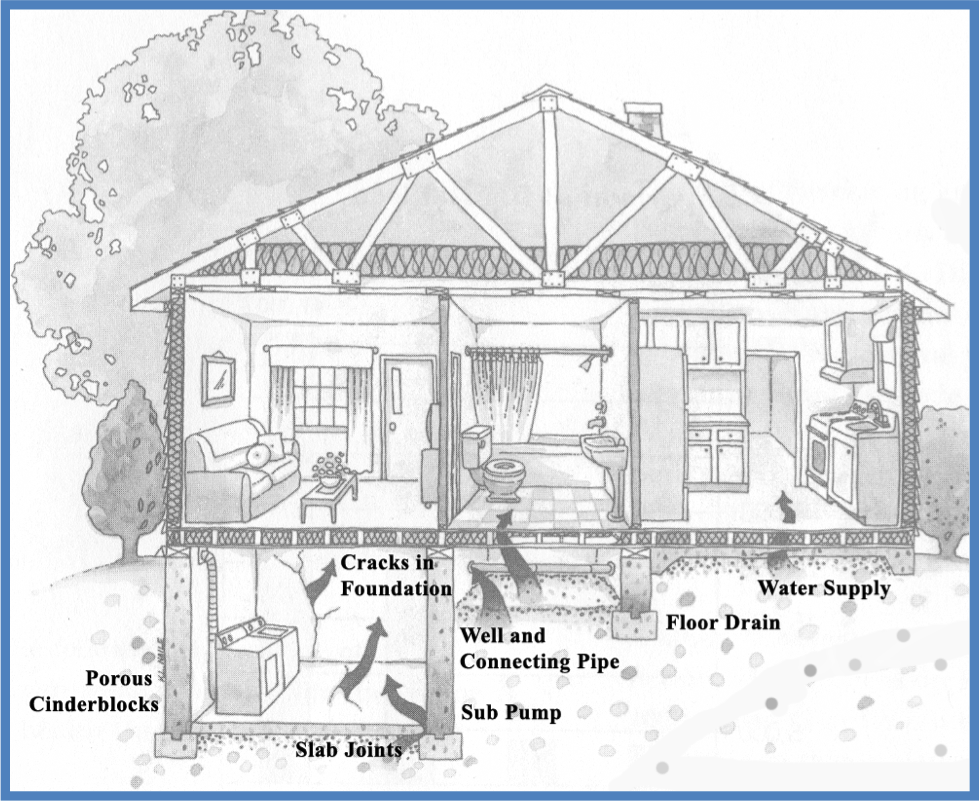- Homes can be built to prevent radon entry.
- Radon-resistant construction includes common building practices and a few added steps.
- Having your builder incorporate radon-resistant features into your new home adds very little cost.
- Homes with radon-resistant new construction features should be tested for radon after occupancy.
- To learn more about these features, obtain and provide your builder with EPA’s booklet, Building Radon Out.
It is much cheaper for homeowners if the pipe and other parts of a radon system are installed into the house during construction. The key to this is making sure the components are installed correctly by the builder. Then these components (referred to as a “passive system”) can be activated if it becomes necessary. This means reviewing how and where the pipe is installed and that if it must be activated, there is enough attic clearance to be able to install a fan and there is a conveniently located electrical source to allow for fan operation .
Installing the passive system is a wise thing to do when building a new home. It is also wise to test your new home for radon. If the levels are still higher than the recommended action level, it will be a simple matter for a qualified radon professional to activate the system.
- Radon tests are often a part of a real estate transaction.
- Requirements for radon testing and/or disclosure of radon levels may be required by law in your area.
- Contact your state radon office for more information.
- EPA’s booklet Homebuyers and Sellers Guide to Radon can help identify and address buyer, seller and real estate agent concerns.
Time constraints imposed by a real estate transaction can create a different set of concerns for addressing radon. The testing is done differently as a result and is usually performed by a third party professional who has no vested interest in the results. If a problem exists, the cost of resolving the problem is, like most things in a real state sale, negotiable. Usually a buyer pays for the radon screening measurement and the two parties go from there depending on the results. The main thing to keep in mind– if you like the house, radon is not a deal breaker, it is a fixable problem. Whether the seller fixes the home before occupancy, or cost estimates of repair are obtained and negotiated, the main thing is to have the work done by a qualified mitigator.
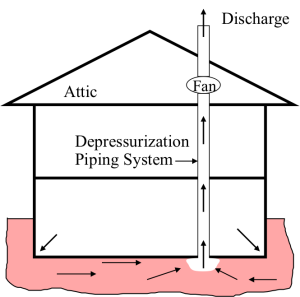
- Suction created by fan draws radon from beneath the concrete slab and safely vents radon outdoors
- Most common type of radon mitigation system
PVC pipe, usually 3-4 inches in diameter, is installed from a hole drilled in the slab. It runs through the home, usually through closet space and exits out the roof. A special quiet, energy-efficient fan is installed in the pipeline at the attic level. The fan pulls the radon from beneath the slab and vents it to the outside, before it can enter the breathable air space of the house. Rarely, it may be acceptable to install the vent on the side wall of a house, but this should be done with extra caution. The pipe exit should not be within 10 feet of a door and window, or radon exiting the pipe could be re-entrained into the house. Also the fan should not be located in the living space. If a leak were to occur on the “up” side of the fan, radon would be pulled into the house at a very high concentration.
- Radon is measured in picoCuries per liter of air (pCi/L). While no level of radon exposure is considered safe, EPA has set an action level at 4 pCi/L.
- If radon test in a home shows levels at or above 4 pCi/L, the home should be fixed.
- The World Health Organization has set a reference level established at 2.7 pCi/L.
Radon results are reported in terms of picocuries per liter of air (pCi/l). Picocuries are a measurement of radiation. While no level of radiation is considered safe, the EPA has established an action level of 4 picocuries per liter. This guideline takes into account both health risks and current technology. In most homes, radon levels can reliably be reduced to this level and often even lower.
The higher the radon level in your home, the more urgent it is to take corrective action to lower the levels and avoid unnecessary health risks.
- Most commonly installed system is called “sub-slab depressurization”.
- System is simple, effective and energy-efficient.
- Uses plumbing-type PVC pipe and a small fan to remove radon.
- In most cases levels can be reduced below 2 pCi/L.
That solution most often would be “sub slab depressurization” or “active soil depressurization.” The real work horse of radon mitigation, this system is used more than 90% of the time. Simply put, it pulls radon from underneath the slab (or in a crawl space from underneath an installed plastic membrane) and vents it to the outside.
DEATHS PER YEAR
According to 2013 CDC statistics, Radon causes more deaths in the United States every year than drunk driving, drownings, fires and airline crashes combined.
153/yr (last decade) Airline fatalities
3468 (upto 2013) Fire fatalities
390/yr (2013-2014) Drowning
9967 Drunk Driving
 As you breathe radon and radon decay products enters your lung. As radon decays, it releases small bursts of energy called alpha particles.
As you breathe radon and radon decay products enters your lung. As radon decays, it releases small bursts of energy called alpha particles.
These energy bursts can damage lung tissue and over time lead to lung cancer. The higher your radon level, the greater your risk of developing lung cancer.
Radon enters your home through openings to the soil in and around your home. The most common pathways include openings around water pipes, sump pumps and drains as well as cracks in the floor wall joints and visible cracks from “settling”.
- Occurs naturally by the decay of uranium in rock and soil.
- Uranium is widely found in trace amounts in soil and rocks.
- Radon in soil and rocks under and adjacent to buildings, migrates through foundations, cracks and small openings and concentrates inside buildings.
Radon is a radioactive gas that occurs naturally by the breakdown of uranium in rock and soil. Radon is one of the nation’s most important environmental threats – one that places people at risk in their own homes.
Radon under and adjacent to buildings, migrates through foundations, cracks and small openings and concentrates inside buildings. It cannot be detected by our senses. You can’t see smell or taste radon. The only way to know if your home has high levels of radon is to test for it.
- Sealing visible cracks is a basic part of most radon mitigation approaches, but sealing alone is NOT enough.
- Opening doors and windows to dilute the radon may sometimes be effective, but it is NOT a practical long-term solution.
Sealing alone is generally not a solution, but an important first step to take. Dilution, opening doors and window, or using forced ventilation to blow fresh air into the basement ( which may also create a positive pressure in the room keeping radon out) can be effective, but is impractical as a long term solution and would typically only be done until a more permanent solution can be implemented.
- Contact your state radon program office.
- EPA’s booklet, A Citizens Guide to Radon, can help you interpret your results and determine next steps.
- Visit EPA’s website at www.epa.gov/radon.
- If the levels in your home are high, take steps to reduce the levels in your home.
A screening measurement between 4 and 20 picocuries per liter should be confirmed with a one year confirmatory test. Between 20 and 200 a follow-up test of no more than three months should be completed. And over 200 picocuries, you should not wait more than a few weeks to take corrective actions.
- Mitigate Your Home for Radon. A Contractor can:
- Install a system to reduce radon levels.
- Prevent it from ever entering the living space.
- Contact your state’s radon program office for a list of qualified radon mitigators.
- EPA’s booklet A Consumers Guide to Radon will be helpful in understanding radon mitigation in your home.
If you have tested and confirmed your measurements and you have elevated radon levels, know that it is a problem which can be fixed. There are three basic approaches to reducing radon levels: prevent its entry by sealing cracks and openings, dilute the levels by increased ventilation and install an active system venting the gas from under the foundation before it enters the house.
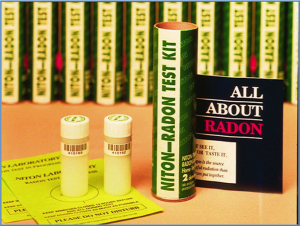
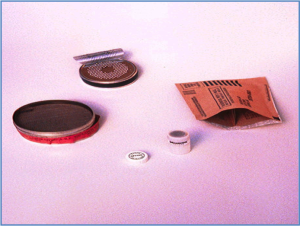
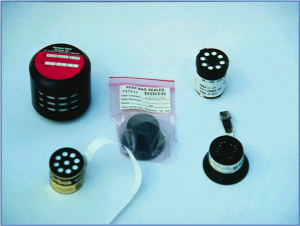
To do a screening test, place a testing device on the lowest livable level of the home for the specified testing period, remembering closed house conditions. A charcoal canister is sensitive to moisture so it should not be placed in a bathroom or kitchen where humidity may be higher.
For practical reasons when conducting test with an alpha track detector, whether for a 3 month screening or a one year confirmatory, closed house conditions can not always be observed, but it is suggested that a portion of the test be done over the winter months when the house is closed up.
Additional: Consider what you are trying to learn about your home when testing; what your family is being exposed to and the worst case scenario, potential risk for the building. Worst case conditions for an initial screening are lowest livable level (no exposed soil is usually considered a “finished” basement) during the winter months. Some people choose to do a concurrent test on the main floor for comparison, especially if they spend little or no time in the basement. In a real estate transaction, the potential risk for the building is at issue because the occupancy patterns of the new residents are unknown, and there are time factors to consider. For more information see the EPA publication Home Buyers and Sellers Guide to Radon.
TESTING IS EASY AND INEXPENSIVE
There are several ways to measure a home for radon. For self-testing, the most commonly used devices are the charcoal detector and the alpha track detector. Both types of detectors come with easy-to-follow instructions. To perform a reliable radon test in your home:
- Obtain a fresh test from a reliable source.
- Follow instructions.
- Deploy the detector and return it to the lab in a timely fashion. For a short term test it is important to observe closed house conditions, meaning all doors and windows are kept closed (except for normal entry and exit) 12 hours prior to the test and for the duration of the test.
These testing devices are placed in the home for 2-7 days for the charcoal detector and from 3 months to a year for the alpha track detector (a long term testing device). Other testing devices are available such as electret ion chambers and active sampling devices often used by radon professionals. These more active sampling devices often can read variations in temperature and barometric pressure changes and movement to detect any possible tampering. They are often used in real estate transactions.
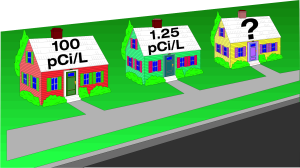 Because radon comes from geology, rock and soil, because geologic formations are not uniform, and because of all of the variables in house construction and occupancy patterns, one home can be high and the one next door low.
Because radon comes from geology, rock and soil, because geologic formations are not uniform, and because of all of the variables in house construction and occupancy patterns, one home can be high and the one next door low.
Note: it is not practical nor feasible to test the soil before constructing a home to predict what the radon level might be.
- The strength of the source; how much uranium/radium is in the soil.
- Porosity of the soil.
- House construction including foundation type: Basement, Crawlspace, Slab-on-grade.
- Weather conditions: Wind, temperature, barometric pressure.
- Occupant activity.
First and foremost, the strength of the source influences radon levels. Secondarily, the type of soil is an important factor. If soil is porous, soil gases (including radon) can travel more easily. Note that soil conditions can change: hard red clay may not allow for soil transport but dry, cracked clay can. Statistically, basement homes are more likely to have elevated radon levels, but high levels have been found in all home types. Normal everyday activity puts a house under negative pressure. Things that “use” or “pull” the air in a house include running a furnace, bathroom or kitchen fan or clothes dryer. Also, a fireplace can pull air from the house. This air is replaced and often the replacement air comes through basement walls and floors, pulling soil gases, including radon, into the house. If a heavy storm or high winds occur, radon levels can be affected too.
Additional note:
Have you ever walked up to a building and tried to pull open the door to enter and the door hits you in the face? Like it’s almost being blown into you? That building is under “positive” pressure. There is so much air in the building, it is rushing to get out. Now think about a building you have tried to enter and you can barely get the door open, and as you do, you can feel the rush of air being pulled in. That building is under “negative” pressure, needing to make up air that has been lost. Or think of the house as a giant vacuum cleaner on the soil, pulling soil gas into the breathable air space of the house to make up the air being lost.
Indoor radon gas is a national health problem. Radon causes thousands of deaths each year. Millions of homes have elevated radon levels. Most homes should be tested for radon. When elevated levels are confirmed, the problem should be corrected.
This health advisory was issued by the EPA and the U.S. Public Health Service. EPA and the Office of the Surgeon General recommend all homes below the third floor be tested for radon.
- National health experts recommend testing your home for radon: U.S. Surgeon General, American Lung Association, American Medical Association, American Cancer Society, American Public Health Association and others.
- 2003 EPA assessment states that 21000 deaths are caused each year. That is more than drunk driving, house fires and drownings combined per year.

